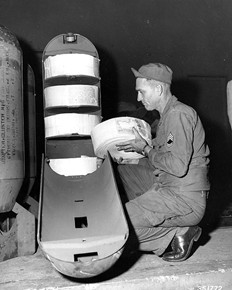 One of the most interesting things about Ug99, the fungus that is currently threatening the world’s wheat supply, is how it managed to sneak up on us. For nearly four decades, the disease that the Puccinis graminis pathogen causes, known as stem rust, was little seen in the wild, and certainly no great peril to farmers. That’s because of the heroic efforts of Dr. Norman Borlaug and his acolytes, who managed to imbue the world’s wheat with genes capable of resisting P. graminis. So as early as the 1960s, agricultural researchers started to forget that stem rust had once been the nastiest plant disease known to man.
One of the most interesting things about Ug99, the fungus that is currently threatening the world’s wheat supply, is how it managed to sneak up on us. For nearly four decades, the disease that the Puccinis graminis pathogen causes, known as stem rust, was little seen in the wild, and certainly no great peril to farmers. That’s because of the heroic efforts of Dr. Norman Borlaug and his acolytes, who managed to imbue the world’s wheat with genes capable of resisting P. graminis. So as early as the 1960s, agricultural researchers started to forget that stem rust had once been the nastiest plant disease known to man.
But you know who didn’t forget? The good folks over at the Pentagon, who spent many years trying to turn stem rust into a bioweapon. To do so was no mean feat, seeing as how they needed to grow and harvest spores of a highly sensitive nature, then figure out a way to drop them on the Soviet Union with no one being the wiser. To accomplish the later task, Army researchers did a little modding of pre-existing hardware:
The most novel innovation was the feather bomb, which featured a 500-pound aerial bomb ordinarily used to spread propaganda leaflets. The bomb was packed with turkey feathers infused with the dust of fungal spores. The feathers were released at high altitudes, drifting over a wide area and coating leaves with spores.
The feathers were the best delivery mechanism because they still retained about 10 percent of their spores despite being subjected to harsh climactic conditions (of the sort you might experience at high altitude). And they also drifted down to Earth with nary a sound, and spread over a wide area so as not to attract the attention of any nosy Soviet farmers.
Needless to say, we never did get around to trying to destroy the Communist wheat crop. But if nothing else, the current Ug99 epidemic proves that our Cold Warriors had a real genius for mischief.


Jordan // Feb 24, 2010 at 12:45 pm
The Soviets certainly had plenty of tricks up their own sleeves. Back in the day I did a project about bioweapons that scared the crap out of me. Thoughts of ICBMs loaded with smallpox and attempts to create smallpox-ebola hybrids are not exactly conducive to getting a good night’s sleep.
Brendan I. Koerner // Feb 24, 2010 at 1:18 pm
Yeah, the Soviets were up to all sorts of dirt, too. I’m sure there are plenty of projects we don’t even know about yet.
BTW, it’s not bioweapons-related, but my friend/colleague Nick Thompson wrote a great piece about the Soviets’ “Doomsday Machine” in an issue of Wired last year. Link here.
Smallpox would be difficult to weaponize, right?
Jordan // Feb 24, 2010 at 7:31 pm
Smallpox probably was difficult to weaponize, but the Soviets definitely pulled it off. Wikipedia article about their bioweapons program says that they had the capacity to churn out 90-100 tons of the stuff every year. That’s an awful lot, especially after smallpox had been nominally eradicated.
At the same time I was doing the bioweapons project, I also did my biology course’s “Endangered Species” project about smallpox (it seemed a lot more interesting than Blackfooted Ferrets). I don’t remember how I did it, but I somehow found a relevant email address at the CDC and asked them how much they had left. The response was something like “For obvious reasons I can’t tell you exactly, but I can say that it fits in a freezer.” Can’t imagine you’d get that kind of reply these days.